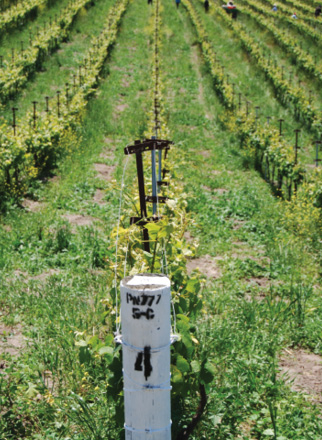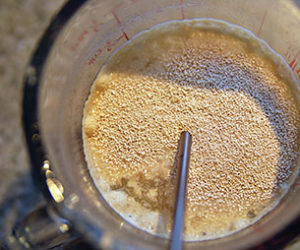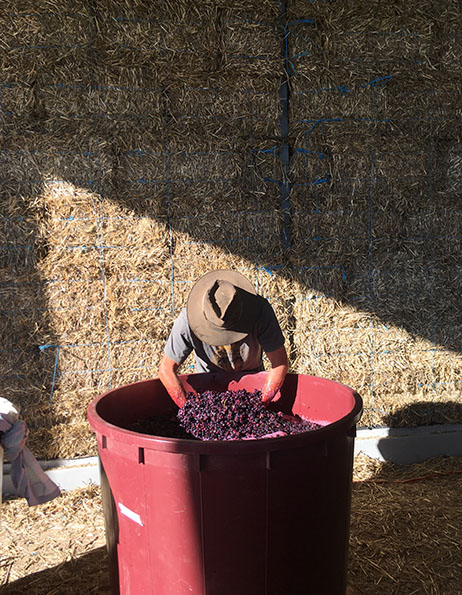
What kind of wine do you want to make? What kind of wines do you and your guests like to drink? Luscious, soft, fruity? Lean, austere, earthy? Tannic, sturdy, powerful? We can encourage these characteristics in the cellar, but, as with anything relating to a wine, the most crucial parts happen in the vineyard.
Aside from choosing an appropriate variety-climate match, the next most important factor is to find a vineyard with as many characteristics as possible that will lead to the style you are looking to produce. This article is about some of the variables within a vineyard that can help you actualize the type of wine you’d like to make, and some work-arounds when certain variables are not in your favor.
In the same way that winemaking is a type of recipe (press grapes, add a certain yeast, add X g/L tartaric acid aiming for 3.Y pH, age on lees Z months, etc..), a vineyard can be looked at in a similar way, with respect to its climate, soils, aspects, and so on. For example: Warm climate for ripe fruit character, but cool nights to maintain balanced acidity. South-facing slope to further encourage development of ripe fruit aromatics, sandy soils for purity of fruit. I’ll give the genealogy of one of my own recipes for success at the end of this article to illustrate how this applies practically.
One would be lucky to find a vineyard exactly suited to their preferences. It’s up to you to decide which characteristics are the most critical for you, which you can live with or change, and which you can doctor up at home! Let’s take a look at how these vineyard factors affect grapes and wine.
CLIMATE
The biggest consideration is climate. The cooler the site, the longer the grapes retain earthy, herbal, “mineral,” and later, spice, characteristics, relative to the development of sugar and loss of acid. Temperatures leading into harvest below 90 °F (32 °C) are common in Burgundy, the Sta. Rita Hills, Ríax Baixas, or the Mosel—all regions that commonly produce earthy wines and big acidity.
The warmer the site, the faster the grapes will get to fruit dominated complexities relative to sugar accumulation and acid loss. Picking grapes early in a hot climate to mimic cool climate acid levels or aroma can result in a wine lacking phenolics, depth or intensity (though that isn’t always the case). Although warm sites may lead to low acid levels, for those wanting fruit- driven wines with a good dollop of acid, look for sites with high daytime temperatures and low nighttime temperatures (a diurnal shift of 35–50 °F (20–28 °C); you want to be in the low 60s °F/~17 °C or even 50s °F/ ~13 °C to retain acid); high daytime temperatures will advance the fruit characteristics you seek, while the nighttime cooling will slow the loss of acid.
ASPECT, LATITUDE, AND ELEVATION
This is a set of factors I find particularly interesting. Light heats grapes just as climate does, and depending on the timing of the most intense light a vine receives, relative to the heat of the day, different patterns of development arise. Aspect refers to the direction a slope faces. East-facing slopes receive their most direct sunlight in the cool
morning hours, west-facing slopes receive their most direct sun in the warmer afternoon hours. In the Northern Hemisphere, north receives the least direct sunlight all day, and south the most direct sunlight all day.
Shaded and cooler grapes will lose malic acid slower than more exposed, warmer grapes. West-facing slopes get the heating effects of both afternoon heat and afternoon sun on their berries, and should lose the most acid (and, as a result, may have more body), east-facing slopes have these two effects at different times during the day, heating up less and retaining more malic acid. Anthocyanins develop without direct sunlight, so this doesn’t mean a west-facing slope will have more color than the east. Flat vineyards get pretty direct sun, cool morning to warm afternoon.
What’s great about this is that differing slopes can exacerbate or diminish the impact of your climate. If you’re in a warm climate, which encourages fruit character, and want as fruit-driven a wine as possible, look for south- and west-facing slopes to potentiate fruit character. But, perhaps you’re in the same area, with no other options, and would prefer a lighter, earthier, or more acidic expression, look for a north- or east-facing slope, hopefully lessening the effects of the warm climate that you would like to avoid, or, at the very least, discouraging overripe fruit character and raisining.
Not all sunlight is created equal. The earth’s atmosphere absorbs and disperses light, weakening it as it travels to its destination. Sunlight hits the equator dead on, traveling through the least atmosphere to reach the ground, and is thus where it is the most intense. At latitudes spreading out toward the poles, sunlight comes in at an ever-increa
sing angle, traveling through more of the earth’s atmosphere as this angle increases, making light progressively less intense toward the poles. The light shining at noon during harvest on Alsace is much less powerful than the midday sun shining on Central Texas. So this is another factor for consideration: A north-facing slope may make sense for your goals in Southern California, but may cause problems in New York.
Elevation works to intensify sunlight at any given latitude, lifting the vineyard up so light travels through less atmosphere before hitting the vines. High elevation also means cooler nights/bigger diurnal swings.
The effects of aspect can be further encouraged and discouraged by pulling more leaves (for more direct sun exposure) or pulling the minimum to ensure good airflow (leaving more leaves in place to create shade on the fruit). Of course, overly exposed and overheated fruit may lose more delicate aromatics, as with hot fermentations and overly shaded fruit can lead to pyrazines and disease.
The cooling effects of wind, how much heat the soil retains, and the cooling and shading effects of fog are also factors to consider.
SOIL
A lot of the how and why of how certain soil types affect grapes is not entirely understood, and much of what is consid
ered fact is based on observation, a methodology where contradictions can always be found.
As far as soil grain size, clay soils often yield earthier wines with more body. As clay retains water better than sand, vines are likely less stressed during ripening, and ripen at a slightly slower pace; aromatics and phenolics can develop slower relative to sugar production. Sandy soils often show particular purity and clarity. As sand itself does not retain water, a vine at harvest may feel more stress, and aromas would ripen faster relative to sugar ripeness, earthier character changing into more pure fruit.
Soil types are extremely variable and unique, but I think it’s worth mentioning some of the wine world’s “great soils”: Soils high in calcareous content or diatomaceous earth (DE), granite soils, and volcanic soils.
WineMaker columnist Wes Hagen has tremendous experience growing vines in high DE content and says that “DE soils and calcareous soils have indistinguishable character. Grapes grown in these soils have thick skins, owing to the soils’ high calcium exchange rate. Vines determine how thick to make their skins based on the amount of calcium available to them. Thick skins means there will be a higher skin-to-juice ratio, and therefore a higher phenolics-to-juice ratio, giving wines with lots of phenolic character. Grapes grown in these soils also have lower pHs, which, if picked with a pH around 3.4 or below, there is tremendous potential for mineral/stony/wet rock character.”
Limestone is the most famous highly calcareous soil type. Regions with calcareous/high DE soils are Burgundy, Bordeaux, Champagne, the Sta. Rita Hills, and Sherry region.
Granitic soil is another revered soil type, which, according to Charlotte Allen, a winemaker in Las Arribes del Duero re
gion of Spain whose wines I import, thinks are the best in the world for grape growing. She agrees mineral/stony and elegant wines can result (think Northern Rhône Syrah, German and Austrian Rieslings, Albariños, and Muscadets). Having worked with granitic soils in the Northern Rhône and now Spain, she says “the pH of granite soil is generally between 5 and 6, which plays a major role in the supply of nutrients to the vine . . . the [high] acidity of the soil means that any added organic matter will decompose very slowly
. . . yields in granite soil are invariably low, which is good for quality, if bad for business!”
Volcanic soils are interesting as well, and getting a bit more attention these days due to the rising fame of Mount Etna in Italy and the Canary Islands of Spain. Closer to home, the Sierra Foothills in California and Willamette Valley of Oregon are home to a lot of volcanic acreage. I’ve always found grapes grown in volcanic soils to have a smoky mineral quality, and often a lot of savory characteristics.
A last note on soils. Soils tended in a way that promote soil “health” and abundant soil life — organically, biodynamically, or without the use of harsh chemicals like glyphosate — are becoming more and more noted for producing wines of more vibrancy and mineral/stony character. Soil life aids vines in the uptake of nutrients, but that’s
just the tip of the iceberg, and something we’re learning more and more about all the time. Of course, there are less organic options, and the grapes come with a premium.
GROWER
Perhaps the most crucial factor of all is to find a grower that you like, and who takes great care of their vines. Even a site that has everything you could hope for — your favorite grape, on the perfect aspect, amazing soil — won’t give you great grapes if your grower isn’t on top of the multitude of responsibilities that are necessary to deliver great, well-balanced, healthy grapes.
BRINGING IT ALL TOGETHER
When I’m looking for a site, I usually start with a style in mind, or, a varietal I’d like to work with. Then I imagine which of the above factors would give me grapes suited for this style or varietal. I’ll lead you through an example on one of my wines, putting together elements from earlier.
I make a Mourvèdre from El Dorado in the Sierra Foothills in California. I initially wanted to purchase Gamay there, but there was a 2-year wait list. However, I fell in love with the beauty and remoteness of the area, and, especially its volcanic soils. I imagined I could make a savory, earthy wine there (owing to these soils), as I had hoped to do with th
e Gamay. Mourvèdre seemed a good fit, being an earthy grape itself. My concern, however, was that El Dorado gets hot (into the low 100s/~40 °C around harvest), and I wanted to make a lighter, elegant wine. The site I found is a north-facing slope, which, despite the high intensity of the sun in El Dorado (in addition to its fairly low latitude, sits at 2,800 feet/850 m), would offer the least sun impact and heat. Due to the high altitude, there is a big diurnal shift, so acidity is retained (Mourvèdre however, loses acidity very early into ripening so acid was necessary!). Also, the grower prunes in a unique way where the grapes receive only dappled sunlight (akin to vertically positioned vines having fewer leaves pulled from the fruit zone), further lowering the impact of the sun and temperatures. The grower is also a great guy, always happy to take a call, who farms precisely and gently, and delivers exceptionally clean fruit. I pick relatively early, which also helps with my style goals. The result, I’m able to make a lighter, delicate, savory, earthy wine, just as I’d hoped, in an area that has characteristics that could potentially work against these style goals.
So, you can see the recipe that I wound up using: Mourvèdre + warm climate + north-facing slope + good leaf coverage + volcanic soil + great grower + early pick = grapes for my style goal. Then, of course, the fun part is finding what the best ways are in the cellar to accentuate what you were looking for in your grapes.
There are endless variables that contribute to grape composition, and we do not understand all of them. Part of the fun of winemaking is the trial and error, and there are endless options to try out. I live in Southern California, with a wide array of options between climate, soil, aspect, varieties, and so on, however, even in areas with less
diversity, there should be much to play with to fine tune your grapes for your style goals.
ADVANCED WINEMAKING
We can
encourage these characteristics in the cellar,
but, as with
anything
relating to a wine, the most crucial parts happen in the vineyard.







